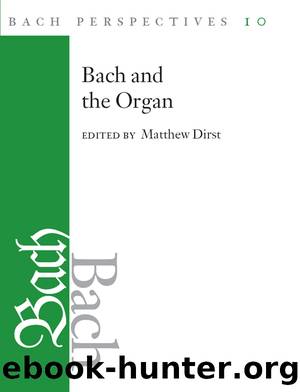Bach Perspectives, Volume 10 by Matthew Dirst

Author:Matthew Dirst
Language: eng
Format: epub
Publisher: University of Illinois Press
Did J. S. Bach Write Organ Concertos?
Apropos the Prehistory of Cantata Movements with Obbligato Organ
Christoph Wolff
Johann Sebastian Bach's third Leipzig cantata cycle, begun on the first Sunday after Trinity in 1725 and spread over more than two years, contains no fewer than four cantatas with extended opening concerto movements that feature virtuoso organ solo parts. One additional such concerto-sinfonia follows in a later cantata from the so-called Picander cycle of 1728. That a composer could lay claim to the liturgy of the Lutheran worship service and turn the church at least momentarily into a concert hall is an extraordinary phenomenon, one without precedent in the history of the church cantata. Although the use of the obbligato organ in church cantatas was by no means new (Bach himself introduced an organ solo in the first aria of his 1708 Mühlhausen cantata BWV 71), a full-scale concerto movement as a cantata opening was definitely a novelty; it took up, after all, a substantial portion of the service. In the case of BWV 146, for example, no less than seven and a half minutes of virtuosic instrumental music are heard before the first words sung by the choir identify the cantata as a piece of sacred music.
Concerto-style sinfonias featuring a virtuoso performer with extensive solo passages, cadenzas, and the like differ conceptually from ordinary and typically concise instrumental introductions to cantata choruses. The former kind of movement shifts the focus from musically enhanced biblical messages and spiritual reflections to an ostentatious instrumental presentation, thereby altering the functionality of the cantata as a musical sermon. A more effective demonstration of Bach's self-confidence and self-esteem is hard to imagine. In just a few years he had managed to carve out for himself a commanding position in Leipzig, and in the realm of church music he clearly held his own vis-Ã -vis the Lutheran clergy. If the consistory had considered such concerto extravaganzas in church services an unwelcome distraction, it could easily have stopped the cantor from mounting such pieces. Curiously, however, nothing at all is known about any such action. On the contrary, since Bach presented cantatas with concertato organ sinfonias not only once but several times between 1725 and 1728âand indeed, by way of repeat performances, throughout his Leipzig tenureâthis can only mean that neither the clergy, the congregation, nor anyone else objected to this innovative type of church music. They may, in fact, have thoroughly enjoyed it.
Table 1 presents an overview of the five pertinent cantatas and their concerto-sinfonias. Not included is the organ sinfonia from BWV 29, a clever arrangement of the Preludio from the unaccompanied violin partita in E major (BWV 1006/1), because it is not strictly speaking a concerto movement. It constitutes, nevertheless, an instrumental movement with a virtuosic solo part, which served in 1729 as the opening for the second part of the wedding cantata Herr Gott, Beherrscher aller Dinge, BWV 120a. In 1731 Bach reused this movement as a sinfonia for the town council election cantata Wir danken dir, Gott, BWV 29.
Download
This site does not store any files on its server. We only index and link to content provided by other sites. Please contact the content providers to delete copyright contents if any and email us, we'll remove relevant links or contents immediately.
The Goal (Off-Campus #4) by Elle Kennedy(12454)
Kathy Andrews Collection by Kathy Andrews(10561)
Diary of a Player by Brad Paisley(6872)
What Does This Button Do? by Bruce Dickinson(5537)
Assassin’s Fate by Robin Hobb(5256)
Big Little Lies by Liane Moriarty(4894)
Pale Blue Dot by Carl Sagan(4019)
Sticky Fingers by Joe Hagan(3459)
The Heroin Diaries by Nikki Sixx(2943)
The Death of the Heart by Elizabeth Bowen(2911)
Beneath These Shadows by Meghan March(2731)
The Help by Kathryn Stockett(2711)
Confessions of a Video Vixen by Karrine Steffans(2685)
How Music Works by David Byrne(2540)
Jam by Jam (epub)(2497)
Harry Potter 4 - Harry Potter and The Goblet of Fire by J.K.Rowling(2422)
Strange Fascination: David Bowie: The Definitive Story by David Buckley(2371)
Petty: The Biography by Warren Zanes(2241)
Darker Than the Deepest Sea by Trevor Dann(2214)
